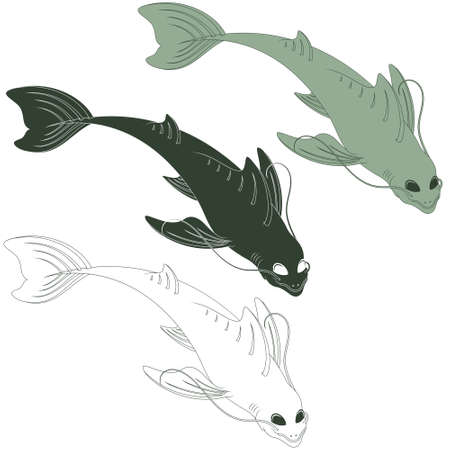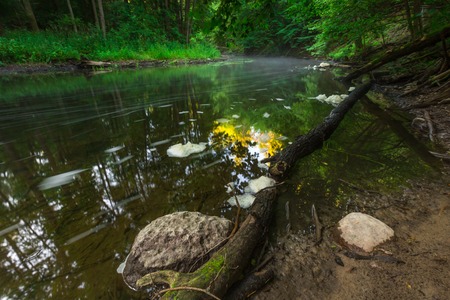Introduction to Tenkara: Origins and Philosophy
Tenkara fishing is a centuries-old Japanese method of fly fishing that has found a passionate following in America. Unlike Western fly fishing, which often involves lots of gear, multiple lines, and complex techniques, Tenkara is all about simplicity and connection with nature. The word “Tenkara” translates roughly to “from heaven” or “from the skies,” reflecting both its elegant technique and its spiritual roots.
The Roots of Tenkara Fishing
Tenkara originated in the mountain streams of Japan, where local anglers—often commercial fishermen—needed an efficient way to catch trout and char in clear, fast-running water. These fishermen used just a long telescopic rod, a fixed line, and a single artificial fly (called a kebari). No reel was required. This minimalist approach allowed them to focus on presentation and stealth rather than equipment.
Minimalism at Its Core
The philosophy behind Tenkara centers on doing more with less. It values skill over gear, patience over power, and observation over complication. Here’s a quick comparison between Tenkara and Western fly fishing:
| Aspect | Tenkara Fishing | Western Fly Fishing |
|---|---|---|
| Rod | Telescopic, no reel | Rod with reel |
| Line System | Fixed length | Multiple lines & backing |
| Gear Needed | Minimal (rod, line, fly) | Extensive (rod, reel, lines, leaders, tippets) |
| Main Focus | Simplicity & technique | Variety & equipment choices |
Tenkara Meets American Outdoor Spirit
The American love for the outdoors is rooted in freedom, exploration, and self-reliance. Tenkara fits right in. It’s lightweight enough for backpackers exploring remote creeks in the Rockies or Appalachian streams. Its simplicity makes it perfect for those who want to spend more time enjoying nature and less time dealing with tangled lines or heavy packs.
Today, American anglers embrace Tenkara not just as a way to fish but as a lifestyle—a return to basics that echoes both Japanese tradition and the spirit of American adventure.
2. Tenkara Gear Essentials: Getting Started
Tenkara fishing stands out for its minimalist approach, making it a fantastic choice for both beginners and seasoned anglers who want to keep things simple on American streams and rivers. Let’s break down the basic gear you’ll need to get started, focusing on equipment that works well in the U.S., from the Rocky Mountains to Appalachian creeks.
Understanding Tenkara Rods
The Tenkara rod is unlike the typical Western fly rod—it’s telescopic, lightweight, and doesn’t use a reel. Most rods collapse down to about 20 inches and extend up to 12 feet or longer, perfect for reaching tricky spots on smaller American waters. For beginners, a rod between 10 and 12 feet hits the sweet spot for versatility and ease of control.
Choosing the Right Rod Length
| Rod Length | Best For |
|---|---|
| 8-9 feet | Tight spaces, small creeks |
| 10-12 feet | General all-around use, most American streams |
| 13+ feet | Larger rivers, longer reach needed |
Tenkara Lines Explained
Tenkara lines are simple—no backing, leaders, or fancy knots required. You’ll mainly find two types: level lines (adjustable in length and easy for casting light flies) and tapered/furled lines (which cast smoothly and are beginner-friendly). For most American waters, an 11- to 13-foot line matches well with your rod length.
Line Type Comparison
| Type of Line | Pros | Cons |
|---|---|---|
| Level Line (fluorocarbon) | Lightweight, easily adjustable length, better for stealthy presentations | Slightly more challenging for beginners to cast in wind |
| Tapered/Furled Line | Easier to cast, gentle presentations, great for new anglers | Slightly heavier, can absorb water over time |
Kebari Flies: The Heart of Tenkara Fly Selection
Kebari is the Japanese term for traditional Tenkara flies. They’re simple in design but extremely effective. In America, you don’t have to limit yourself—classic kebari patterns work well, but so do popular Western dry flies and nymphs. Start with a few basic kebari in different sizes (12-16), plus some local favorites if you know what’s hatching on your home waters.
Sample Starter Fly Box for American Waters:
- Sakasa Kebari (reverse hackle) – Sizes 12-16
- Pheasant Tail Nymphs – Sizes 14-18
- Elk Hair Caddis – Sizes 14-16
- Parachute Adams – Sizes 14-16
- Black Ant or Beetle Patterns – Sizes 12-16
Assembling Your Beginner-Friendly Setup
Here’s how to put it all together:
- Select a 10–12 foot Tenkara rod that feels comfortable in your hand.
- Attach an 11–13 foot level or furled line using a simple girth hitch knot at the tip of your rod.
- Add about 3–4 feet of tippet (4X or 5X works great).
- Tie on your chosen fly—start with a sakasa kebari or whatever’s hatching locally.
- Pack light! All you really need beyond this setup is a pair of hemostats, nippers, and maybe a net if you’re hoping to land bigger fish.
This stripped-down gear list lets you focus on what makes Tenkara special—the connection between angler, fish, and water. With these essentials tailored for American rivers and creeks, you’ll be ready to hit the water with confidence!

3. Techniques and Tactics: Mastering the Tenkara Cast
The Essence of the Tenkara Cast
Tenkara fishing stands out for its simplicity, especially when it comes to casting. Unlike Western fly fishing, which often uses heavier rods, reels, and a variety of line weights, Tenkara employs a lightweight rod with no reel and a fixed line. This means your casting motion is more about precision and subtlety than power.
Basic Tenkara Casting Technique
- Grip: Hold the rod lightly with your thumb on top for control.
- Stance: Stand with feet shoulder-width apart for stability.
- Cast: Use a gentle flick of the wrist, swinging the rod from the 10 o’clock to 12 o’clock position—think of tossing paint off the tip of a brush.
- Presentation: Let the fly land softly on the water, aiming for natural drift and minimal splash.
Tenkara vs. Western Fly Fishing: Key Differences
| Aspect | Tenkara | Western Fly Fishing |
|---|---|---|
| Rod Length | Typically 10-14 feet | Usually 7-9 feet |
| Reel | No reel, fixed line | Uses a reel for line management |
| Casting Style | Shorter, softer casts; focus on accuracy and delicate presentation | Variety of casting styles; can be longer and more powerful casts |
| Gear Complexity | Minimalist (rod, line, fly) | More complex (rod, reel, backing, leaders, multiple flies) |
Presentation Styles Unique to Tenkara
Tenkara anglers often use techniques that maximize their ability to keep the line off the water, reducing drag and creating a lifelike drift. Some favorite methods include:
- Dapping: Gently dipping or bouncing the fly on the surface to mimic emerging insects.
- Pulsing: Slightly twitching the rod tip to animate the fly underwater.
- High-Sticking: Holding the rod high to keep most of the line off fast currents, allowing for a natural drift in tricky spots.
Tenkara Fish-Catching Strategies
- Stealth Approach: Because you can make short, accurate casts with little splash, Tenkara is perfect for sneaking up on wary trout in small streams.
- Tactical Positioning: Use your long rod to reach over obstacles like rocks or brush that would snag traditional fly lines.
- Sight Fishing: With fewer distractions from gear, you can focus on spotting fish and delivering precise presentations right where they feed.
- Simple Fly Selection: Many Tenkara anglers stick with just one or two effective fly patterns (like the traditional Japanese “kebari”) and concentrate on changing their technique rather than swapping flies constantly.
Tenkara Tips for American Waters
If youre fishing American rivers and streams with Tenkara gear, try adapting these traditional Japanese methods to local conditions. Experiment with both upstream and downstream drifts, work pocket water between rocks, and don’t be afraid to get creative with how you move your fly. The minimalist approach makes it easy to focus on your skills—and thats really what sets Tenkara apart from other forms of fly fishing in America.
4. Hot Spots: Tenkara Opportunities Across America
Tenkara fishing may have its roots in Japan, but American anglers have quickly discovered just how well this minimalist fly fishing style fits into the diverse landscapes of the United States. Whether youre a seasoned Tenkara veteran or just getting started, there are plenty of waters across the country where Tenkara shines. Here’s a look at some of the best places to cast your line and a few regional tips for making the most of your Tenkara experience.
Top U.S. Locations for Tenkara Fishing
| Region | Recommended Waters | Notable Features |
|---|---|---|
| Appalachia (East Coast) | Great Smoky Mountains, Shenandoah National Park, Blue Ridge streams | Small mountain streams, wild brook trout, lush forests |
| Rocky Mountains (West) | Colorado Rockies, Yellowstone tributaries, Montana creeks | Crisp alpine water, cutthroat and rainbow trout, scenic vistas |
| Pacific Northwest | Cascade Range, Olympic Peninsula creeks, Oregon Coast Range | Mossy rivers, steelhead runs (small fish ideal for Tenkara), rain-soaked beauty |
| Northern Midwest | Driftless Area (Wisconsin/Minnesota/Iowa), Michigan Upper Peninsula streams | Limestone spring creeks, brown trout, easy wading access |
| Sierra Nevada & California Mountains | Yosemite tributaries, Tahoe area streams, Kings Canyon creeks | Clear granite flows, wild trout species diversity, iconic scenery |
Regional Tips for Adapting Tenkara Technique
Appalachian Streams
The tight canopies and clear water of Appalachian streams make shorter Tenkara rods (10-11 feet) a smart choice. Stealth is key—approach pools quietly and use delicate presentations to fool wary brookies.
Western Rockies & High Country Creeks
These wide-open spaces let you use longer rods (12-13 feet) and lighter lines. Expect quick strikes from hungry cutthroats in fast-moving riffles. Don’t be afraid to experiment with traditional Japanese kebari patterns here.
Pacific Northwest Rivers
If targeting small native trout in mossy creeks, opt for a lightweight rod that handles well in tight quarters. For bigger water or small steelhead, beef up your tippet and try slightly larger flies.
Northern Midwest Spring Creeks
Limestone creeks call for subtlety—choose fine tippets and tiny flies to match local hatches. Driftless streams often feature overhanging banks; practice bow-and-arrow casts to reach tricky spots.
Sierra & California Mountain Streams
The crystal-clear water means fish spook easily. Use long leaders and keep your silhouette low against the sky. Small attractor patterns work well for wild rainbows and browns.
5. Tenkara Community and Culture in America
Across the United States, Tenkara fishing has moved from a niche curiosity to a thriving community-driven movement. American anglers have embraced this simple Japanese style of fly fishing, making it their own while building a unique culture around it.
Growing Tenkara Communities
Tenkara clubs and social groups have sprung up in states from Colorado to North Carolina. Many of these communities organize regular meet-ups, stream cleanups, group outings, and skill-sharing workshops. Online forums and social media groups like Tenkara Anglers USA and local Facebook groups connect enthusiasts across the country, creating a space for sharing tips, stories, and event info.
Popular Tenkara Events in the U.S.
| Event Name | Location | Highlights |
|---|---|---|
| Tenkara Jam | North Carolina | Workshops, demos, gear swaps, community fishing |
| Tenkara Summit | Colorado (varies yearly) | Guest speakers, on-stream clinics, vendor booths |
| Rocky Mountain Tenkara Fest | Utah/Colorado border | Beginner classes, fly tying sessions, river outings |
American Makers and Innovation
A new generation of rod makers and small businesses are popping up all over America. Brands like Tenkara USA, Zen Tenkara, and DRAGONtail Tenkara have reimagined traditional rods with materials and designs tailored for American streams and fish species. Fly tyers experiment with patterns that blend Japanese simplicity with classic U.S. trout flies. Accessories like line holders and rod cases now come in rugged styles fit for backpackers and backcountry explorers.
How Americans Are Making Tenkara Their Own
- Diverse Waters: While classic Tenkara is associated with mountain streams for trout, Americans use it for panfish in farm ponds, bass in small rivers, and even backpacking trips into remote alpine lakes.
- Crossover Techniques: Many anglers blend Tenkara with Western fly fishing tactics—using weighted flies, adapting rod lengths, or experimenting with nymphing methods.
- Community Spirit: The do-it-yourself ethos is strong; many enthusiasts build their own lines or tie their own kebari flies, sharing patterns online or at meetups.
- Youth & Diversity: Outreach programs introduce kids and new anglers to fishing through Tenkara’s approachable techniques and gear.
The Heart of Tenkara in America
Tenkara’s appeal lies not just in its simplicity but also in the sense of connection—with nature, fellow anglers, and a centuries-old tradition given new life on American waters. Whether you’re casting for wild trout in the Rockies or sunfish at your local park pond, you’ll find a welcoming community ready to share the joy of Tenkara fishing.


